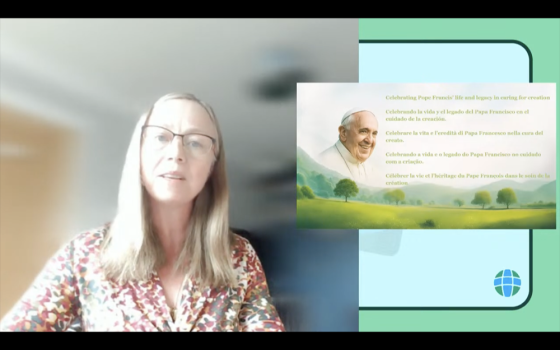
Religious Life -- Essay
When the Vatican announced a visitation of the women’s religious communities, it prompted many happy memories of sisters. These aren’t the stories the visitors will hear. But maybe they should.
My long connection with the sisters began in high school, shortly before the Second Vatican Council. I was the annoying student who posed the pesky questions that stumped Sr. Harriet, our theology teacher. It didn’t take a genius, even in 10th grade, to ask, “If the Mass is our most important prayer, why is it in a language we don’t understand?” She had more trouble with “Why won’t my kindly Baptist relatives go to heaven?” but that may have been my misperception of Catholic teaching. A few years after the council, Sr. Harriet had the grace to phone. “Remember all those questions?” she laughed. “You were right.”
Never once did the Religious of the Sacred Heart tell us that girls should be pretty and dumb. Au contraire. They modeled that women should use their gifts and intelligence. One college professor was the first cloistered nun to earn a doctorate in physics in the United States; another set up our honors program on the same model she’d followed in graduate studies at Oxford University. Department chairs, deans or college presidents? Of course women would fill those roles with skill and dignity.
The sisters adapted with grace and fidelity to enormous changes brought on by the council, moving out of the cloister and into a society many were unfamiliar with. But they knew, deep down, instinctive human courtesy and compassion. When my mother was dying, her colleagues and friends at the college where she taught were sisters. They walked steadily and courageously through that final illness with us, and remained motherly figures to me for years after her death.
Servite Sr. Joyce Rupp, knowing I was trying to write my first book, Hidden Women of the Gospels, asked, “How can you concentrate with four kids at home? Use my apartment when I’m away!” I marveled at her understanding and later at her generosity when she wrote the foreword.
Sisters’ networks promoted books and cheered my first efforts at giving retreats. Wait -- didn’t this work the other way around? Weren’t they supposed to give retreats to laypeople? When a Jesuit director asked Sr. Eleanor to give a mother-daughter retreat, she refused. “What would I know about that? Get a mother-daughter team!” Her honesty opened the door for my daughter and me to direct those amazing experiences for five years.
Change didn’t flummox such secure women: They were supportive and kind as roles reversed. The Australian Ursulines flew me there to give their province retreat for sisters from South Africa, Thailand and throughout Australia. I secretly wondered what a frazzled mother could possibly tell them, but they were consistently warm and appreciative.
Afterwards, the provincial and I spent many hours driving around the country, because they wanted to expose their speakers to rural areas beyond Sydney. A town west of the Blue Mountains was unusually cool one evening, and most houses don’t have central heating. The elderly nun at whose home we were staying sidled up before I began an evening talk. “I’ve turned on your bed for you,” she whispered. I puzzled about that for a while. Turned out she had kindly warmed it up with a “wooly underlay,” which we’d call a heated mattress pad.
Back in the United States, at a local retreat center, several of us arrived the evening before the retreat began. Sr. Rita was somewhat addicted to a harmless television program, and asked a Peruvian staff member why none of the TV sets seemed to work. Seeking to reassure her, he grinned broadly, “Yes, we have no channels!” That lovely non sequitur quickly upstaged any inspiration I’d hoped to give during the retreat.
The Victory Noll sisters were unwitting stars of the show during the retreat at their motherhouse in Huntington, Ind. One 93-year-old told how she’d visited St. Peter’s in Rome on the same day as a mother and her daughter from Kansas. The daughter was wearing shorts and the guards wouldn’t allow her to enter. Her mother was agonizing that they’d come so far and couldn’t see any of the treasures within. “Then I remembered,” Sister brightened. “I was wearing a half-slip. So right there in the Vatican, I dropped my petticoat. The girl wore it over her shorts; the guards were happy and off they went. They’re probably still praying for me.”
As I read the Song of Songs (“Arise, my beloved and come ...”) to the elderly sisters, some dozed. Others were bent over, their heads poking out like turtles. But they displayed photos of their profession days when, slim and erect, they carried candles and wore bridal gowns. They had taken risks, lived in Bolivia, or the adobe buildings of Santa Fe. Now in walkers or wheelchairs, their tasks are folding napkins worn soft with many uses. Unlikely as it may seem, they are the portrait of fidelity.
On a brilliant spring day at Victory Noll, a spry 89-year-old gave a tour of the grounds in her golf cart. She had labeled every tree on the property with a small plaque that identified its species, and each had a name of a sister, every sister in their community, living and dead. Some sisters make regular visits to “their” tree. On Arbor Day, fifth-graders from the local school visited -- and each one left with a sapling to plant at home.
My work in religious education continued my early friendships with the sisters. I remember going to a restaurant for dinner with several sisters after the San Antonio religious education congress. “Watch this,” said one in habit as we entered the crowded bar for a drink while we waited. “I can clear out this place faster than lightning.” Indeed, we were whisked to an empty table in a flash.
One of my best friends, a Sister of St. Joseph, practices a similar technique, since she and I don’t like sharing the hotel hot tub with teenagers. So she’ll ask kindly if my “disease” is still contagious and I’ll respond with a sweet inquiry about the state of her (imagined) oozing sores. Funny how fast the kids leave. Meanwhile, I take quiet delight in this Sister of St. Joseph wearing a swimsuit. When I was growing up, nuns were draped in head-to-toe black habits. I’d secretly wonder if they had feet.
The same friend, hearing on the phone that I have a nasty cold, arrives the same day with a basket of citrus. In the same generous way, she brought her famous homemade spaghetti to my new home on moving day. She works with the marginalized women of Denver -- prostitutes, ex-felons, those who struggle to earn a GED. Symbolic of her work: In her backyard are 37 fruit trees left by the house’s former owner. But where do the birds choose to nest? In a hanging basket on her back porch, where they’ve hatched many eggs. That speaks volumes about the secure nests she’s made for the most frail and vulnerable people.
My spiritual director, a Sister of Charity in her 80s, fills my annual eight-day retreat with practical guidance. No “Consider the lilies of the field” advice from her. She’s brutally frank: “You need a financial planner.”
She intuited how money worries were undermining my spiritual life -- and knew exactly how to improve the situation.
Of course it’s impossible to generalize about any group of unique individuals. Those reporting to the Vatican may have a hard time summarizing all the varied works and personalities of sisters in the United States. Rigid labels will slide right off: liberal/conservative, outgoing/reserved, active/contemplative. The only generalization that holds true paraphrases John Patrick Shanley’s dedication for his play “Doubt.” In tribute to the order who taught him in grade school, he admits that we’ve all made fun of sisters and enjoyed jokes at their expense. But few among us have served with more generosity or compassion. Amen.
Kathy Coffey gives retreats and workshops nationally and internationally. Her latest book is The Art of Faith (Twenty-Third Publications).



